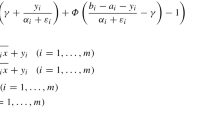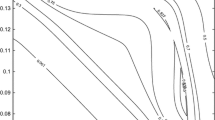Abstract
The present paper investigates Gaussian bilateral inequalities in view of solving related probability maximization problems. Since the function f representing the probability of satisfaction of a given Gaussian bilateral inequality is not concave everywhere, we first state and prove a necessary and sufficient condition for negative semi-definiteness of the Hessian. Then, the (nonconvex) problem of globally maximizing f over a given polyhedron in \(\mathbb {R}^{n}\) is adressed, and shown to be polynomial-time solvable, thus yielding a new-comer to the (short) list of nonconvex global optimization problems which can be solved exactly in polynomial time. Application to computing upper bounds to the maximum joint probability of satisfaction of a set of m independent Gaussian bilateral inequalities is discussed and computational results are reported.
Similar content being viewed by others
References
Bienstock, D., Chertkov, M., Harnett, S.: Chance-constrained optimal power flow: risk-aware network control under uncertainty. S.I.A.M Rev. 56(3), 461–495 (2014)
Boyd S., Vandenberghe L., Convex Optimization, Cambridge University Press, ISBN: 9780521833783, http://stanford.edu/~boyd/cvxbook.html (2004)
Branda, M., Novotný, J., Olstad, A.: Fixed interval scheduling under uncertainty—a tabu search algorithm for an extended robust coloring formulation. Comput. Ind. Eng. 93(C), 45–54 (2016)
Charnes, V., Cooper, W.: Chance-constrained programming. Manag. Sci. 6, 73–79 (1959)
Cheng, J., Lisser, A.: A second-order cone programming approach for linear programs with joint probabilistic constraints. Op. Res. Lett. 40(5), 325–328 (2012)
Cheng, J., Houda, M., Lisser, A.: Chance constrained \(0-1\) quadratic programs using copulas. Optim. Lett. 9(7), 1283–1295 (2015)
Grant, M., Boyd, S.: The CVX Users’ Guide, CVX Research, Inc., http://cvxr.com/cvx/doc/CVX (2013)
Henrion, R., Strugarek, C.: Convexity of chance constraints with independent random variables. Comput. Optim. Appl. 41, 263–276 (2008)
Henrion, R., Strugarek, C.: Convexity of chance constraints with dependent random variables: the use of copulae. In: Bertocchi, M., Consigli, G., Dempster, M.A.H. (eds.) Stochastic optimization methods in finance and energy. International series in operations research & management science, vol. 163, pp. 427–439. Springer, New York (2011)
Hiriart-Urruty, J.B., Lemaréchal, C.: Convex Analysis and Minimization Algorithms. Springer, Berlin (1993)
Le Cam, L.: Maximum likelihood: an introduction. Intern. Stat. Rev. 58(2), 153–171 (1990)
Minoux, M., Zorgati, R.: Convexity of Gaussian chance constraints and of related probability maximization problems. Comput. Stat., Online: ISSN 0943-4062, April 2015 (DOI 10.1007/s00180-015-0580-z), Print: ISSN 0943-4062, March 2016, Volume 31, Issue 1, pp 387-408 (2015) (doi:10.1007/s00180-015-0580-z), Springer
Moreau, J.J.: Proximité et dualité dans un espace Hilbertien. Bull. Soc. Math. Fr. 93, 273–299 (1965)
Nemirovski, A., Shapiro, A.: Convex approximations of chance constraints. SIAM J. Optim. 17, 969–996 (2006)
Nesterov, Y., Nemirovski, A.: Interior-Point Polynomial Algorithms in Convex Programming. In: Studies in Applied and Numerical Mathematics, SIAM Series. Society for Industrial and Applied Mathematics, SIAM Editor, Philadelphia (1994). ISBN 978-0-89871-319-0
Prekopa, A.: Stochastic Programming. Kluwer, Dordrecht (1995)
Sahinidis, N.V.: Optimization under uncertainty: state-of-the-art and opportunities. Comput. Chem. Eng. 28, 971–983 (2004)
Sakalli, U.S., Baykoç, O.F., Birgören, B.: Stochastic optimization for blending problem in brass casting industry. Ann. Op. Res. 186, 141–157 (2011)
Souza, Lobo M., Vandenberghe, L., Boyd, S., Lebret, H.: Applications of second-order cone programming. Linear Algebra Appl. 284, 193–228 (1998)
Van Ackooij, W., Henrion, R., Möller, A., Zorgati, R.: On probabilistic constraints induced by rectangular sets and multivariate normal distributions. Math. Methods Op. Res. 71, 535–549 (2010). doi:10.1007/s00186-010-0316-3
Van Ackoiij, W., Henrion, R., Möller, A., Zorgati, R.: On joint probabilistic constraints with gaussian coefficient matrix. Op. Res. Lett. 39, 99–102 (2011)
Vavasis, S.A.: Nonlinear Optimization: Complexity Issues. Oxford Science, New York (1991)
Wright, S.J.: Primal-Dual Interior-Points Methods. SIAM, Society for Industrial and Applied Mathematics, Philadelphia (1997)
Acknowledgements
The authors gratefully acknowledge two Referees for their careful review of the manuscript and their insightful comments, which gave rise to a significantly improved revised version.
Author information
Authors and Affiliations
Corresponding author
Appendices
Appendix 1 : Results used in proof of Theorem 1
We provide in this Appendix two results which are used in the proof of Theorem 1.
Proposition 5
H denoting the Hessian of the function \(\varPhi (\frac{b-\mu ^{T}x}{\sqrt{x^{T}\varSigma x}})+\varPhi (\frac{\mu ^{T}x-a}{\sqrt{x^{T}\varSigma x}})-1\), checking negative semi-definiteness of H is equivalent to checking negative semi-definiteness of
where \(\alpha \) and \(\beta \) are defined by (1) and (2) in the statement of Theorem 1, and \(V=\varSigma ^{1/2}x\) and \(W=\varSigma ^{-1/2}\mu \).
Proof
Using the expressions given in the proof of Theorem 1 in [12] , the Hessian of \(\varPhi (\frac{b-\mu ^{T}x}{\sqrt{x^{T}\varSigma x}})\) is equal to :
with:
where \(\theta _{b}=\frac{(b-\mu ^{T}x)^{2}}{x^{T}\varSigma x}\). Since \(\frac{(1-\theta _{b})}{(b-\mu ^{T}x)}\)can be rewritten as \(\frac{ (1-\theta _{b})}{\sqrt{\theta _{b}}}\frac{1}{\sqrt{x^{T}\varSigma x}}\), an equivalent expression for \(\widehat{H}_{b}\) is:
In a similar way, we get the expression of the Hessian of \(\varPhi (\frac{\mu ^{T}x-a}{\sqrt{x^{T}\varSigma x}})\) as :
with:
and \(\theta _{a}=\frac{(\mu ^{T}x-a)^{2}}{x^{T}\varSigma x}\).
Let \(\pi _{a}=e^{\frac{-\theta _{a}}{2}}(\mu ^{T}x-a)\) and \(\pi _{b}=e^{ \frac{-\theta _{b}}{2}}(b-\mu ^{T}x)\). Note that \(\pi _{a}\ge 0\), \(\pi _{b}\ge 0\) and \(\pi _{a}+\pi _{b}>0\) since it has been assumed that \(a\le \mu ^{T}x\le b\) and \(a<b\).
Then \(H=\triangledown _{x}^{2}\) \(\varPhi (\frac{b-\mu ^{T}x}{\sqrt{x^{T}\varSigma x }})+\triangledown _{x}^{2}\varPhi (\frac{\mu ^{T}x-a}{\sqrt{x^{T}\varSigma x}})\) can be written as:
Checking negative semi-definiteness of H is equivalent to checking negative semi-definiteness of \(\pi _{a}\widehat{H}_{a}+\pi _{b}\widehat{H} _{b}\) and this, in turn, is equivalent to checking negative semi-definiteness of :
where \(\overline{H_{a}}=\varSigma ^{-1/2}\widehat{H}_{a}\varSigma ^{-1/2}\) and \( \overline{H_{b}}=\varSigma ^{-1/2}\widehat{H}_{b}\varSigma ^{-1/2}\).
Now, setting \(V=\varSigma ^{1/2}x\) and \(W=\varSigma ^{-1/2}\mu \), and denoting I the \(n \times n\) unit matrix, it is easily seen that:
and :
Introducing the coefficients :
we get expression (7) for \(\bar{H}\). \(\square \)
Next, given two vectors \(Y \in \mathbb {R}^n, Z \in \mathbb {R}^n (Y\ne 0, Z\ne 0)\), we prove the following result concerning the largest eigenvalue \(\bar{\lambda }\) of the \(n \times n\) matrix \(YY^{T}-ZZ^{T}\), with rank at most 2:
Proposition 6
-
(i)
The largest eigenvalue for \(YY^{T}-ZZ^{T}\) reads:
$$\begin{aligned} \bar{\lambda }=\dfrac{\parallel Y \parallel ^{2}-\parallel Z \parallel ^{2}+\sqrt{\left( \parallel Y \parallel ^{2}+\parallel Z \parallel ^{2} \right) ^{2}-4\left( Z^{T}Y\right) ^{2}}}{2} \end{aligned}$$(14) -
(ii)
A necessary and sufficient condition for ensuring \(\bar{\lambda } \le 1\) is
$$\begin{aligned} \parallel Y \parallel ^{2}-\parallel Z \parallel ^{2}+\parallel Y \parallel ^{2}\parallel Z \parallel ^{2}-\left( Z^{T}Y\right) ^{2} \le 1 \end{aligned}$$(15)
Proof
-
(i)
Since the special case when Y and Z are colinear is easily checked to be encompassed by (14), it is not restrictive to assume that Y and Z are linearly independent. First, it is observed that the two eigenvectors corresponding to the two possibly nonzero eigenvalues necessarily lies in the subspace generated by Y and Z, and this is an easy exercice to show that the two eigenvalues looked for coincide with the eigenvalues of the \(2 \times 2\) matrix
$$\begin{aligned} \left[ \begin{array}{cc} \parallel Y \parallel ^{2} &{} \left( Z^{T}Y\right) \\ -\left( Z^{T}Y\right) &{} -\parallel Z \parallel ^{2} \end{array} \right] \end{aligned}$$The corresponding characteristic equation reads:
$$\begin{aligned} \lambda ^{2}+\left( \parallel Z \parallel ^{2}-\parallel Y \parallel ^{2}\right) \lambda - \parallel Y \parallel ^{2} \parallel Z \parallel ^{2}+\left( Z^{T}Y\right) ^{2} = 0 \end{aligned}$$the discriminant of which is:
$$\begin{aligned} {\varDelta }= & {} \left( \parallel Z \parallel ^{2}-\parallel Y \parallel ^{2}\right) ^{2}+4 \parallel Y \parallel ^{2} \parallel Z \parallel ^{2}-4\left( Z^{T}Y\right) ^{2} \\= & {} \left( \parallel Z \parallel ^{2}+\parallel Y \parallel ^{2}\right) ^{2}-4\left( Z^{T}Y\right) ^{2} \end{aligned}$$From this, (14) immediatly follows.
-
(ii)
In view of (14), \(\bar{\lambda } \le 1\) can be rewritten as:
$$\begin{aligned} \sqrt{\left( \parallel Z \parallel ^{2}+\parallel Y \parallel ^{2}\right) ^{2}-4\left( Z^{T}Y\right) ^{2}} \le 2-\parallel Y \parallel ^{2}+\parallel Z \parallel ^{2} \end{aligned}$$which, after squaring, yields:
$$\begin{aligned} 4\parallel Y \parallel ^{2}\parallel Z \parallel ^{2}-4\left( Z^{T}Y\right) ^{2}+4\parallel Y \parallel ^{2}-4\parallel Z \parallel ^{2} \le 4 \end{aligned}$$thus completing the proof.
\(\square \)
Appendix 2 : Polynomial algorithm BPM
Based on Theorem 2, we provide here the formal statement of a polynomial-time algorithm to determine the maximum of \(\hat{\varPsi }\left( t\right) \) on \(\left[ t_{\min },t_{\max } \right] \) within a confidence interval of width less than \(\epsilon \). The interval reduction technique used here is the well-known golden section search method, which asymptotically requires a minimum number of function evaluations.

In each step of the procedure, the width of the confidence interval is reduced by the factor \(r\simeq 0.618\), therefore an upper bound on the number q of iterations required to meet the requested accuracy \(\epsilon \) is such that:
or equivalently: \(q=\lceil \frac{1}{\ln (\frac{1}{r})} \left( \ln \left( \frac{1}{\epsilon } \right) + \ln \left( \frac{b-a}{2} \right) \right) \rceil \). As stated in the proof of Theorem 2, this bound is proportional to \(\ln \left( \frac{1}{\epsilon } \right) \), and, since each evaluation of \(\widehat{\varPsi }(t)\) is computable in polynomial time, this shows that (BPM) runs in polynomial time.
Rights and permissions
About this article
Cite this article
Minoux, M., Zorgati, R. Global probability maximization for a Gaussian bilateral inequality in polynomial time. J Glob Optim 68, 879–898 (2017). https://doi.org/10.1007/s10898-017-0501-5
Received:
Accepted:
Published:
Issue Date:
DOI: https://doi.org/10.1007/s10898-017-0501-5




